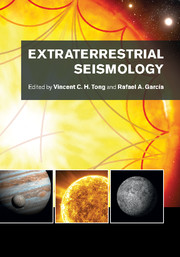Book contents
- Frontmatter
- Contents
- List of contributors
- Preface
- Acknowledgements
- List of abbreviations
- Planetary seismology: High risk, high return
- A bright outlook for helio- and asteroseismology
- Part I Observation and space missions
- Part II Data and physical parameters
- 4 Asteroseismology: From the telescope to the modeler's desk
- 5 Global helioseismology and asteroseismology of solar-type stars
- 6 Measurements with local helioseismology
- 7 Planetary seismology: Early observational results
- Part III Modeling approaches
- Part IV Discoveries of physical structures and processes
- Part V Interdisciplinary research involving planetary and astrophysical sciences
- Part VI Interdisciplinary research involving terrestrial seismology
- References
- Index
6 - Measurements with local helioseismology
from Part II - Data and physical parameters
Published online by Cambridge University Press: 05 July 2015
- Frontmatter
- Contents
- List of contributors
- Preface
- Acknowledgements
- List of abbreviations
- Planetary seismology: High risk, high return
- A bright outlook for helio- and asteroseismology
- Part I Observation and space missions
- Part II Data and physical parameters
- 4 Asteroseismology: From the telescope to the modeler's desk
- 5 Global helioseismology and asteroseismology of solar-type stars
- 6 Measurements with local helioseismology
- 7 Planetary seismology: Early observational results
- Part III Modeling approaches
- Part IV Discoveries of physical structures and processes
- Part V Interdisciplinary research involving planetary and astrophysical sciences
- Part VI Interdisciplinary research involving terrestrial seismology
- References
- Index
Summary
Introduction
Local helioseismology encompasses remote observations, data analysis, and theoretical modeling of solar oscillations to infer the three-dimensional structure within localized regions of the solar interior. What defines a region as “local” is relative, however, since targets of interest have included sunspots and convective elements with spatial scales ∼10−2R⊙ as well as large-scale plasma flows spanning much of a solar hemisphere. As a relatively new discipline first explored in the 1980s, local helioseismology has two main components: first, a research component to understand the interaction of solar oscillations (acoustic and surface gravity) with perturbations within the Sun and, second, the design and application of methods to infer the properties of the perturbations by modeling the measurements of those waves. Successful applications require a thorough understanding of the physics of the waves and their interaction with in homogeneities inside the Sun. The research component is particularly critical. For example, the types of perturbations found in the Sun can include magnetic fields for which the wave interactions can be quite complicated. Currently, the types of structures most amenable to modeling using local helioseismic measurements consist of isotropic wave-speed perturbations and the three components of plasma flows. Assessing the subsurface magnetic field directly is a challenging, but largely unrealized, goal of the field. While the status of the field is evolving, the determination of plasma flows in the first few tens of Mm below the solar surface remains one of the primary practical applications.
We outline in this chapter the practical applications of, and resulting measurements made with, common local helioseismic methods. Broadly speaking, local helioseismology can be roughly divided into Fourier methods (which operate in the frequency–wave number domain) and cross-covariance based methods (which operate in the space–time domain). The former (Section 6.3) can be considered in many ways as extensions of the analysis of global oscillations (Chapter 5) to localized regions of the Sun.
- Type
- Chapter
- Information
- Extraterrestrial Seismology , pp. 77 - 90Publisher: Cambridge University PressPrint publication year: 2015
- 1
- Cited by



